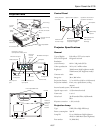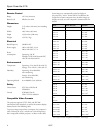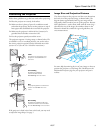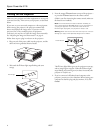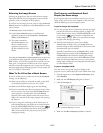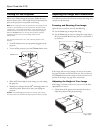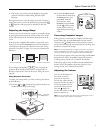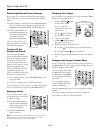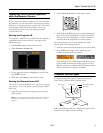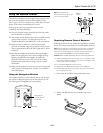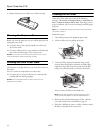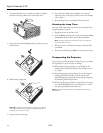
Epson PowerLite 6110i
12/07 5
Selecting the Image Source
Selecting the image source lets you switch between images
input from different pieces of equipment connected to the
projector (such as a computer or DVD player).
If you don’t see the image you want, select it using the
Source
Search
button on the projector or the Source buttons on the
remote control.
The
Source buttons work as follows:
❏ Use the
Source Search button to switch between
equipment connected to the
Computer1, Computer2,
Video, and S-Video ports.
❏ The remote control has
four
Source buttons. Use
them to switch between
equipment connected to
the port identified on each
button.
Note that the
Computer1 and Computer2 ports can be set up
to use different input signals (for example, Analog RGB or
RGB Video)—so if you have equipment connected to one of
these ports, it’s important to make sure the correct signal is
selected to match the equipment you’re using. You can change
the input signal settings using the projector’s menu system; see
the User’s Guide for instructions.
What To Do If You See a Blank Screen
If you see a blank screen or a blue screen with the No Signal
message, try the following:
❏ Make sure the cables are connected correctly, as described
on the Quick Setup sheet and in your User’s Guide.
❏ Make sure the P Power light is green and not flashing.
❏ If you’ve connected more than one computer and/or video
source, you may need to press the
Source Search button
on the projector’s control panel or one of the
Source
buttons on the remote control to select the correct source.
(Allow a few seconds for the image to appear after pressing
the button.)
❏ If you’re using a PC notebook, press the function key on
your keyboard that lets you display on an external monitor.
It may be labelled
CRT/LCD or have an icon such as .
You may have to hold down the
Fn key while pressing it.
Allow a few seconds for the projector to sync up after
changing the setting.
The Projector and Notebook Don’t
Display the Same Image
If you’re projecting from a notebook, and you can’t see your
image on the screen and on your computer at the same time,
check the following for your computer system.
If you’re using a PC notebook:
❏ On most systems, there’s a function key that lets you toggle
between the LCD screen and the projector, or display on
both at the same time. It may be labelled
CRT/LCD or with
an icon such as . You may have to hold down the
Fn key while pressing it. Allow a few seconds for the image
to appear after changing the setting.
❏ If the function key doesn’t permit you to display
simultaneously on both screens, you should check your
monitor settings to make sure both the LCD screen and the
external monitor port are enabled.
From the Control Panel, open the
Display utility. In the
Display Properties window, click the
Settings tab, then
click
Advanced. The method for adjusting the settings
varies by brand; you may need to click a
Monitor tab, then
make sure the external Monitor port is set as your primary
display and/or enabled. See your computer’s documentation
or online help for details.
If you’re using Mac OS X:
You may need to set up your system to display on the
projector screen as well as the LCD screen. Follow these steps:
1. From the Apple menu, select
System Preferences, then
select
Displays.
2. Make sure the
VGA Display dialog box is selected.
3. Click the
Arrange tab.
4. Make sure the
Mirror Displays checkbox is selected.
Select the
VGA Display
dialog box
Make sure Mirror Displays is checked



